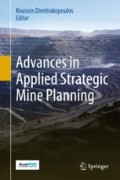Abstract
Mining companies seek to mine, route and process ore to make the most efficient use of capital equipment during the life of the mine. The situation analysed in this paper relates to optimisation of medium-term production strategy for a group of mines and metallurgical plants. Typical operations under this scenario involve mining of crude ore from shafts and/or open pits; transportation of ore to the milling plants, run-of-mine stockpiles and leach-pads. The concentrate from the mill(s) is sent to the smelters and refineries, from where the finished metal is sent to the markets. If one assumes that the grade of run-of-mine ore varies according to source and that the milling plants are designed to handle different types of ore, plus the fact that mines and plants may separate by considerable distances, optimisation of the production plan becomes imperative. Most of the publications dealing with the subject of mine production planning are limited to mine scheduling optimisation and do not include metallurgical plants. However, the nature of the problem requires the application of a model that incorporates all the elements of the mineral production system. The methodology outlined in this paper is based on a Network Linear Programming formulation of the production-planning problem for a mining and metallurgical complex. Network LP models are particularly useful in analysing production-distribution type systems such as the one involving a group of mines and metallurgical plants. The problem is formulated using the theory of dual-primal relationships in linear programming. The solution algorithm finds the minimum cost of production and distribution, hence the optimal production and material routing plan for a group of mines and metallurgical plants. The graphs of optimality conditions for each arc in the network could be exploited as a tool for strategic mine planning. The advantages of this formulation are outlined and its application is demonstrated using a hypothetical situation involving an integrated mining and metallurgical complex, specifically six mines, five concentrators, three smelter and two copper refineries. A computer program called Linear Integer Discrete Optimiser (LINDO) is used to solve the network linear programming model. This program allows the user to quickly input an LP formulation, solve it and perform ‘what if’ type analyses.
Access this chapter
Tax calculation will be finalised at checkout
Purchases are for personal use only
References
Ahuja RK, Thomas LM, Orlin JB (1993) Network flows—theory, algorithms and applications, Prentice-Hall, 846 p
Bazaraa MS, Jarvis JJ, Sherari HD (1990) Linear programming and network flows, 2nd edn. Wiley, 565 p
Chanda EK (1990) An application of integer programming and simulation to production planning for a stratiform orebody. Min Sci Technol 11:165–172
Dagdelen K, Topal E, Kuchta M (2000) Linear programming applied to scheduling of iron ore production, at the Kiruna Mine, Sweden. In: Panagiotou GN, Mikhalakopoulos, TN (eds) Proceedings ninth international symposium on mine planning and equipment selection, Balkema, Rotterdam, pp 187–192
Fulkerson DR (1961) An out-of-kilter method for minimal cost flow problems. SIAM J Appl Math 9:18–27
Graham-Taylor T (1992) Production scheduling using linear and integer programming. In: Proceedings 1992 AusIMM annual conference, The Australasian Institute of Mining and Metallurgy, Melbourne, pp 159–162
Hoerger S, Bachmann J, Criss K, Shortridge E (1999) Long term mine and process scheduling at Newmont’s Nevada operations. In: Dagdelen K (ed) Proceedings 28th international symposium on computer applications in the minerals industries, Society for Mining, Metallurgy, and Exploration, Littleton, pp 740–748
King B (2001) Optimal mine scheduling. In: Edwards AC (ed) Mineral resource and ore reserve estimation—the AusIMM guide to good practice, The Australasian Institute of Mining and Metallurgy, Melbourne, pp 451–458
Ramazan S (2001) Open pit mine scheduling based on fundamental tree algorithm. Ph.D. thesis, Colorado School of Mines, Mining Engineering Department
Ramazan S, Dimitrakopoulos R (2004) Recent applications of operations research and efficient MIP formulations in open pit mining. SME Trans 316:73–77
Ricciardone J, Chanda EK (2001) Optimising life of mine production schedules in multiple open pit mining operations: a study of effects of production constraints on NPV. Min Resour Eng 10(3):301–314
Saul B (1990) Optimisation of waste haulage with linear programming. In: Singhal RK (ed) Proceedings Mine Planning and Equipment Selection, Balkema, Rotterdam, pp 455–461
Scheepers L, Wellbeloved D (1992) Optimisation of integrated mining and metallurgical complexes by means of linear programming and case study. In: Survival strategies for the metallurgical industry, South African Institute of Mining and Metallurgy, Johannesburg
Schrage L (1999) Optimisation modelling with LINGO, LINDO Systems Inc, 530 p
Thomas GS (2001) Optimisation of mine production scheduling—the state-of-the-art. In: Edwards AC (ed) Mineral resource and ore reserve estimation—the AusIMM guide to good practice, The Australasian Institute of Mining and Metallurgy, Melbourne, pp 441–450
Author information
Authors and Affiliations
Corresponding author
Editor information
Editors and Affiliations
Rights and permissions
Copyright information
© 2018 The Australasian Institute of Mining and Metallurgy
About this chapter
Cite this chapter
Chanda, E.K. (2018). Network Linear Programming Optimisation of an Integrated Mining and Metallurgical Complex. In: Dimitrakopoulos, R. (eds) Advances in Applied Strategic Mine Planning. Springer, Cham. https://doi.org/10.1007/978-3-319-69320-0_18
Download citation
DOI: https://doi.org/10.1007/978-3-319-69320-0_18
Published:
Publisher Name: Springer, Cham
Print ISBN: 978-3-319-69319-4
Online ISBN: 978-3-319-69320-0
eBook Packages: Earth and Environmental ScienceEarth and Environmental Science (R0)

